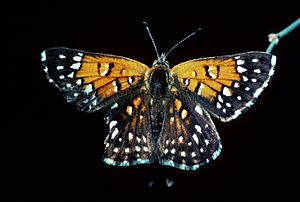Lange's metalmark butterfly facts for kids
Quick facts for kids Lange's metalmark butterfly |
|
|---|---|
 |
|
 |
|
| Conservation status | |
| Scientific classification |
|
| Kingdom: | Animalia |
| Phylum: | Arthropoda |
| Class: | Insecta |
| Order: | Lepidoptera |
| Family: | Riodinidae |
| Genus: | Apodemia |
| Species: | |
| Subspecies: |
A. m. langei
|
| Trinomial name | |
| Apodemia mormo langei Comstock, 1938
|
|
The Lange's metalmark butterfly (scientific name: Apodemia mormo langei) is a very rare butterfly found in North America. It is a type, or subspecies, of the Mormon metalmark butterfly. This special butterfly belongs to a group of butterflies called Riodinidae, also known as metalmark butterflies.
This butterfly lives only in California, in a tiny area along a riverbank in the San Francisco Bay Area. It is an endangered species, meaning it is at risk of disappearing forever. In 2008, scientists counted only 131 of these butterflies. By 2011, that number had dropped even more, to about 25 to 30 butterflies. This makes it one of the rarest butterflies in the world.
Contents
What Does the Lange's Metalmark Butterfly Look Like?
The Lange's metalmark butterfly is a delicate and colorful insect. Its wings usually spread about 1 to 1.5 inches (25 to 38 mm) wide. The top of its wings are mostly black with bright white spots. You'll also see a striking red-orange color on the front part of its top wings and near the base of its back wings. There's also a small orange patch in the middle, surrounded by black.
If you look at the underside of its wings, the colors are softer. They show a mix of gray, white, black, and orange patterns.
Where Do Lange's Metalmark Butterflies Live?
This butterfly has been listed as an endangered species by the United States government since 1976. This means it has special protection to help it survive.
Historically, Lange's metalmark butterflies lived only on sand dunes along the southern bank of the Sacramento River. Today, they are found in just one place: the Antioch Dunes in Contra Costa County, California. Even though it's called "Antioch Sand Dunes," most of the sand was removed a long time ago. Now, it's a hilly area with scrub plants.
Most of the area where they live is now part of the Antioch Dunes National Wildlife Refuge. This refuge is managed by the Don Edwards San Francisco Bay National Wildlife Refuge Complex. Scientists regularly count the butterflies here. Sometimes there are a few hundred, and sometimes more than a thousand. Even with a recovery plan in place since 1984, the butterfly's habitat still needs more protection.
Why Are These Butterflies Endangered?
In the early 1900s, the unique sand dune habitat in the Sacramento–San Joaquin River Delta started to change a lot. People began taking the sand to make bricks. This large-scale sand mining and other industrial building broke up the sand dunes. Only a tiny part of the original habitat was left.
Also, new plants that were not native to the area started to grow. These nonnative grasses and other plants crowded out the special plants that the butterflies and other endangered species needed. By the time the Antioch Dunes Refuge was created, only a few acres of the original dune habitat remained. This small area supported the last natural groups of Lange's metalmark butterflies, along with two rare plants: the Antioch Dunes evening primrose and the Contra Costa wallflower.
Moving sand is very important for the health of the dunes. It creates open spaces where new plants can grow. However, farming tools like roto-tillers have helped nonnative plants spread. These plants make the sand dunes stable, which stops the sand from moving. This also means they compete with the native plants that belong there.
Protecting the Lange's Metalmark Butterfly
Efforts to help the butterflies include restoring the dunes and carefully removing nonnative plants by hand. Workers also plant buckwheat seedlings, which is a key food source for the butterflies. Public access to the area is limited to prevent people from accidentally stepping on plants or causing fires.
Since 2007, a special environmental group has been raising these butterflies in captivity. They release young butterflies (larvae) and adult butterflies back into the wild. This helps make sure that if the wild population gets too small, there will still be butterflies to help it recover.
Life Cycle of the Lange's Metalmark Butterfly
All stages of the Lange's metalmark butterfly's life happen very close to its main food plant, which is a type of buckwheat (Eriogonum nudum ssp. psychicola).
The female butterflies lay their eggs on buckwheat leaves, usually near the leaf stem. They do this during a short mating flight that lasts only about 10 days. The tiny butterfly larvae, or caterpillars, hatch during the rainy months. These larvae eat only buckwheat leaves.
Adult butterflies drink nectar from buckwheat flowers and sometimes from a plant called butterweed (Senecio douglasii). They also use silver lupine (Lupinus albifrons) plants for mating.
Unlike many butterflies that have several generations in a year, the Lange's metalmark butterfly has only one. This means they reproduce only once a year. Scientists are still learning about the full life cycle and exact needs of this unique butterfly.
Images for kids




